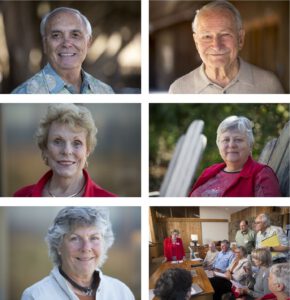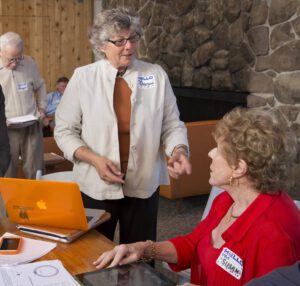Some people gather in book clubs to chat over plot twists in the latest novel they’ve read, but Susan Clark and her friends meet in a cozy room off the kitchen at the Sea Ranch Lodge on the rugged coast of Northern California to talk about the twists and turns in their own DNA.
“It’s been a real bonding experience,” said Susan, an architectural historian. “This is something that’s just totally new, that also has a real social element to it. None of us are experts. Most of us have some sort of advanced degree, but we’re babies at this.”

Clockwise from top right, Doug Patterson, Morgan Lambert, Kalynn Oleson, the group discussing their results, Sharon Albert and Susan Clark.
Shared Experience
Susan and her friends started exploring personal genetics about a year ago. She and her husband read an article about 23andMe and decided to try it. Their results came in just as they were on a short vacation with two other couples in Mexico.
“We were so excited by the volume and variety of information that we couldn’t stop talking about it,” she said. That’s what got the other couples interested.”
It didn’t stop there.
Uncovering Stories
When they returned, Susan and Tom talked so much about their ancestry and health results that other people in the tight-knit community decided to get tested. Sea Ranch is a beautiful but relatively isolated enclave on the coast, and the people who live there – many of them retired – rely on each other for a lot. They gather frequently for different activities, from wine tasting to bridge to salon discussions and writing groups. This became another interest in drawing them together. Susan soon found herself at the center of discussions about genetics.
“We’d joke about our Neanderthal percentage, claiming that we now had an excuse for our bad behavior,” she said.
Or they’d support each other on more severe issues about potential health risks.
Health Data
Sharon Albert, one of Susan’s friends at Sea Ranch who’d tested after finding 23andMe on her own, was always anxious about looking at her risk for Alzheimer’s disease. (Customers can choose to “unlock” their results for Alzheimer’s or leave them locked and unopened.)
Susan told Sharon: “Let’s sit down on a Friday afternoon with a stiff drink and look together.”
That’s what they did, and fortunately, Sharon didn’t have any of the variants associated with higher risk. In fact, Sharon jokingly said her results were “kind of boring. There’s nothing wrong with me.”
But for Sharon, the lack of any big genetic risks felt empowering.
“For me, it turned things around,” she said.
Instead of looking for something in her genetics that explains away health issues or other things, she’s looking at how she lives her life.
“It made me realize that I’m in control of my health,” she said.
Starting a Conversation
Now, she’s quantifying much of what she does. She monitors her sleep, her diet, and how much exercise she gets each day. She’s controlling her own fate, she said.
At first, it was just Susan, Sharon, and one or two others who’d bring their iPads and laptops to the lodge to discuss their 23andMe results over coffee, but not for long. The group quickly grew to six and then ten. At one point, a waitress serving breakfast got sucked into a conversation and was so intrigued she eventually got tested. Soon, the group began having regularly scheduled meetings.
During their meetings, they discuss what they’ve discovered about themselves or offer insights from articles they’ve read on the latest genetic discoveries.
Sometimes, what they talk about is just for fun. Sometimes it’s serious. Sometimes, it’s just plain fascinating.
Morgan Lambert learned, to his surprise, that he had hidden African ancestry.

Sharon, standing, and Susan discussing their 23andMe results.
“I don’t have any obvious African features, so I was intrigued,” said Morgan, who asked 23andMe if maybe there was a mistake.
There wasn’t.
For the retired Marin County school superintendent, the results offered him a connection to a father he’d never known.
“A way to learn a little about who he was,” Morgan said.
Family Stories
For Doug Patterson, a regular group member, the test helped him dig up a fascinating family history. It took a little legwork, but through 23andMe, he connected with a third cousin on his mother’s side of the family in Buckingham County, Virginia.
Using 23andMe’s DNA Relatives, he exchanged messages offering up information about his mother’s family, the Catletts, and his great-grandmother. He didn’t know much about her; her last name may have been “Steger” or “Steiger.” Doug learned from one of his DNA cousins that the name was “Steger” and that the Steger family had descended from Hessians, or German mercenary soldiers used by the British during the Revolutionary War. The largest prisoner-of-war camp was in Albemarle County, next door to Buckingham, and after the war, about 5,000 of these soldiers ended up settling in the colonies. He was a descendant of one of those soldiers.
“Learning this was an adventure for me,” he said.
Kalynn Oleson tested out of curiosity about her ancestry. An adoptee, she didn’t know much about her biological family, but she also didn’t feel compelled to find them.
An Adoptee’s Journey
In her career, she has worked in collections for banks and other financial institutions and is good at finding people. It wouldn’t have been difficult for her to find her biological mother. Although her name was on her birth certificate, she never tried to contact her.
“I never felt the need to,” said Kalynn. “I also figured I’d be intruding.”
Although Kalynn was born in Washington, her biological family’s roots were in Michigan. Her biological mother had been in Washington State during WWII to work as a nurse when she became pregnant. Although Kalynn never felt she needed to connect to her biological family when she was younger, she wanted to know more about her ancestry as she grew older.
“But I was cautious,” she said.
She had basic information about her mother, but that’s it. She tested with 23andMe and very quickly learned she had two half brothers, one of whom passed away within a few weeks of her discovering his existence. The other she recently wrote a letter to.
“It was tortuous to write,” she said.
How do you explain to someone that they have a 67-year-old half-sister they never knew they had? However, these new contacts taught Kalynn that her grandfather and grandmother had come from Purmo, Finland.
For Susan, who started all this, each of the stories from her friends has given her a chance to understand more about genetics and the potential for learning more about yourself. She’s also discovered that sometimes what might appear insignificant for others—a slightly increased risk for some health condition or a distant cousin match—can be very important for you if it concerns your own results.
“It has also given me a chance to be proactive regarding my health risks,” she said.
She learned that she has a risk for deep vein thrombosis, something for which she had no family history.
“But since I received the results, I am far more conscientious about getting out of my seat and moving around on a plane. It’s a small, simple act, but for me, it might prevent what could be a big problem.”